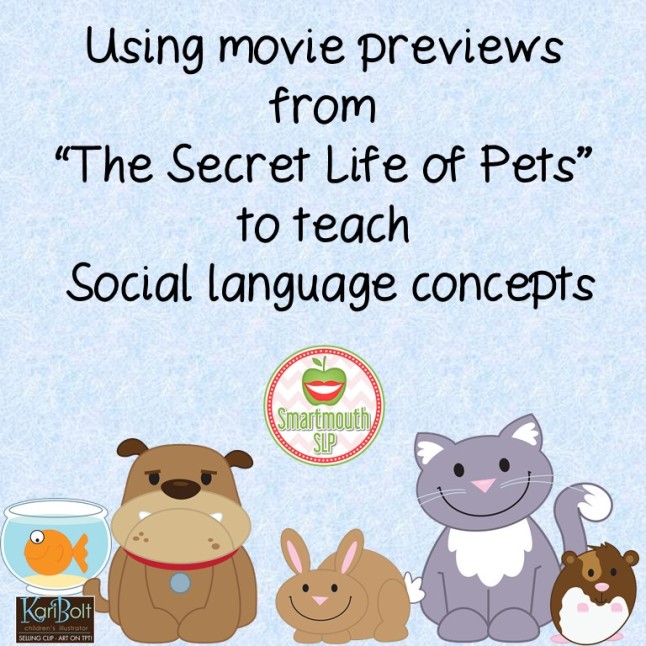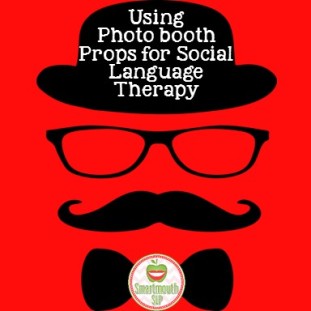
“They can’t talk, so how should I know what they would say??” This is a quote from a young man I was working with when I showed him a picture of a dog and asked him to tell me what it might be thinking or saying. He looked at me, arms crossed, with a loud, unsaid “duh!” hanging in the air between us. Over the next few sessions, we talked about imagining, wondering, and using context clues to make a guess about what something (or someone) might be thinking, saying or feeling. I used a scaffold of materials to work on this, moving from pictures, to social scenarios, commercials and short video clips from movies. There are lots of great preview clips on Youtube that can be so helpful in working on these concepts!
My own boys are older, but I still enjoy a good animated movie now and again (I am not talking to you Sponge Bob Square Pants). Last summer, I dragged my 16 year old with me to see Inside Out with the promise of unlimited popcorn (it worked like a charm)! We both ended up enjoying the movie, probably me more than him. There were so many great moments to use in therapy to talk about emotions, predictions, and how our actions affect others! Is it wrong that I look at most movies like these as possible social language material? I’d like to think that it’s equal parts brain bonus/occupational hazard, but I’m a glass half-full kind of girl.

The Secret Life of Pets from Universal Pictures and Illuminations Entertainment coming July 2016
There is a new movie full of social language possibilities opening this summer, The Secret Life of Pets, from the same people who made the Minion movies. They have started releasing previews that are hilarious and PERFECT to work on the concepts of thinking, feeling and saying using context clues. Here is a link to a Christmas card themed clip . There are seven pets getting their pictures taken for holiday cards. This would be fun to use when we return to school in the post-holiday doldrums of January!
One caveat about this clip: it lasts 1:46 minutes but I would only show through the 1:15 minute mark. There is a bit of an inappropriate guinea pig moment with a computer mouse after the 1:15 time that I would avoid!! Consider yourselves warned!!
Each of the seven pets is featured for about 10 seconds. Show each clip, pause it and then have the students decide what kind of personality traits each pet has (goofy, hyper, clumsy, etc..). Talk about what clues might lead you to make these guesses. You might want to write out the choices on sticky notes for support or have your students brainstorm personality descriptors before/during the activity. I talk about a time I have seen those personality traits in people I know, including myself. Building connections between what we are practicing and real life experiences is so important. Otherwise we are teaching skills that aren’t easily integrated beyond our therapy rooms!
The next thing to decide would be determining how the pet feels about getting their picture taken. This is a great exercise in looking at facial expressions. Animation typically over-exaggerates expressions and this is very helpful for our students with ASD! Talk about the eyes, mouth, body posture, all the non-verbal clues that help us determine how someone/something is feeling.
If my students have pets, I ask them to try and think about these same activities with their own animals. Again, connecting personal experiences to social language lessons really helps our kids gain a deeper understanding of these skills. These clips are full of opportunities to talk about how and why questions. You can extend the lesson with your students who have basic perspective taking skills and ask them to guess:
What the pet owners might be thinking or feeling when their pets were getting their pictures taken?
What is the person taking the pictures of the pets thinking/feeling at the end of the clip?
What the people who receive this Christmas picture might be thinking?
They only show two humans in the clip, so this will take some out of the box imagination skills and making good guesses! It’s much harder to make a guess about things we can’t see but must infer. There are several other clips being released, but I hope they aren’t showing all the funny parts now (I am always disappointed when I feel like I have seen the movie before I see the movie)! You can check out the other preview here and work on related concepts over several weeks!
What the pets do when their people are gone: (2:40 seconds) Fantastic for prediction and inferences (cat in the refrigerator with food, dog with squirrel), predictable/unpredictable behaviors (a prissy French Poodle head banging to System of a Down) and comparing/contrasting what the pet owners think pets do all day versus what the pets actually do!
What other movie clips have you used to teach social language concepts? I really like The Dabbling Speechie’s Elf themed ideas for therapy! Share your finds here!



